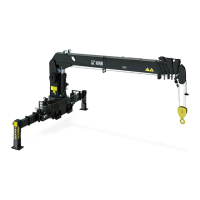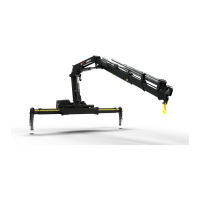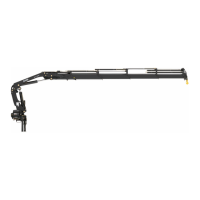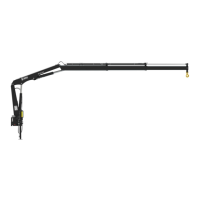Do you have a question about the HIAB 160TM and is the answer not in the manual?
Describes the components and organization of the operator's manual.
Explains the meaning of symbols, warnings, and notes used in the manual.
Details additional symbols and conventions used for clarity in the manual.
Emphasizes the critical importance of reading and understanding the manual.
Specifies the necessary qualifications and experience for operating the crane safely.
Defines the environmental and operational conditions for safe crane use.
Details correct crane usage and defines safe lifting capacity limits.
Outlines essential pre-operation checks and safety measures before starting work.
Provides instructions and safety guidelines for general crane operation.
Details the step-by-step procedure for safely initiating crane operations.
Explains the safe methods and precautions for performing lifting and moving operations.
Describes the correct procedures for safely concluding crane operations.
Provides safety instructions and warnings related to driving the vehicle with the crane attached.
Covers the safe selection, installation, and usage of lifting accessories.
Details safety procedures for mounting and dismounting the crane from the vehicle.
Outlines safety precautions and guidelines for performing maintenance and service on the crane.
Describes common faults, their potential causes, and safety measures for rectification.
Explains the conditions under which HIAB provides warranty for the crane.
Provides detailed technical specifications and performance data for the crane.
Presents a visual overview and dimensional data of the crane's main components.
Details the crane's lifting capacities at various working radii and boom angles.
Illustrates the hydraulic system layout and component connections for the crane.
Explains the fundamental hydraulic principles and power flow for crane operation.
Identifies and lists the primary structural and functional components of the crane.
Describes the crane's base structure, its connection to the chassis, and mounting.
Details the design and function of the crane's column, supporting the boom system.
Explains the construction of the boom system, including extensions and cylinders.
Describes the control valves and their safety functions for crane operation.
Details the outrigger system's function in stabilizing the crane and preventing tilting.
Describes the winch's construction, installation, and integrated mechanical brake.
Explains the PTO and pump's role in providing hydraulic power for crane operation.
Describes the oil tank's components and function for the hydraulic system.
Details the optional top seat, its control valve, and adjustability for operator comfort.
Explains the optional anti-two-block system and its function in preventing over-winding.
Lists essential pre-operation checks and setup steps before starting crane work.
Provides procedures for warming up the hydraulic system in cold temperatures to prevent damage.
Explains the function of outrigger control levers and the procedure for deploying outriggers.
Details the standard control levers and their functions for operating the crane's movements.
Describes the operation of the overwinding alarm system and how to respond if activated.
Outlines the necessary steps to secure the crane for driving after completing operations.
Emphasizes smooth crane operation to reduce wear and prevent component troubles.
Ensures proper outrigger system extension and grounding before crane operation.
Provides a checklist for daily inspections of various crane components to ensure safe operation.
Advises on checking slewing system noise and periodic inspection of mounting bolts.
Explains the correct procedure for fitting and attaching the wire rope to the boom.
Provides guidelines for changing hydraulic system filter inserts for optimal operating economy.
Lists key points to check during crane operation, including leakage and oil temperature.
Details checks to perform after operating the crane to ensure readiness for the next use.
Outlines inspection and maintenance tasks required after the first month of crane operation.
Specifies the inspection and maintenance schedule for every six months of crane operation.
Explains the procedure and importance of regularly changing hydraulic oil to maintain system health.
Presents a detailed chart specifying lubrication points, intervals, lubricants, and quantities.
Describes the hand signal for lifting a load, involving wrist rotation.
Explains the hand signal for lowering a load, using energetic hand movements.
Details the hand signal for stopping all crane movements or holding a load in position.
Illustrates the hand signal for initiating an emergency stop for all crane movements.
Describes the hand signal for indicating a very short movement of the load.
Explains the hand signal used to indicate a change in the crane's reach or load position.
Details the hand signal used to indicate the direction of turning for the crane or load.
Describes the hand signal for opening the grapple mechanism.
Explains the hand signal for closing the grapple mechanism.
Details the hand signal for lifting the grapple slightly.
Describes the hand signal for holding the grapple in a specific position.
| Brand | HIAB |
|---|---|
| Model | 160TM |
| Category | Construction Equipment |
| Language | English |











